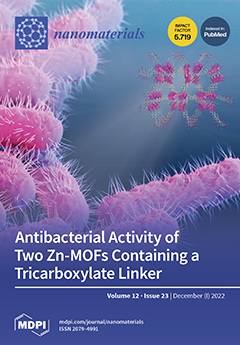The present work aimed at decorating halloysite nanotubes (HNT) with magnetic Fe
3O
4 nanoparticles through different synthetic routes (co-precipitation, hydrothermal, and sol-gel) to test the efficiency of three magnetic composites (HNT/Fe
3O
4) to remove the antibiotic ofloxacin (OFL)
[...] Read more.
The present work aimed at decorating halloysite nanotubes (HNT) with magnetic Fe
3O
4 nanoparticles through different synthetic routes (co-precipitation, hydrothermal, and sol-gel) to test the efficiency of three magnetic composites (HNT/Fe
3O
4) to remove the antibiotic ofloxacin (OFL) from waters. The chemical–physical features of the obtained materials were characterized through the application of diverse techniques (XRPD, FT-IR spectroscopy, SEM, EDS, and TEM microscopy, thermogravimetric analysis, and magnetization measurements), while ecotoxicity was assessed through a standard test on the freshwater organism
Daphnia magna. Independently of the synthesis procedure, the magnetic composites were successfully obtained. The Fe
3O
4 is nanometric (about 10 nm) and the weight percentage is sample-dependent. It decorates the HNT’s surface and also forms aggregates linking the nanotubes in Fe
3O
4-rich samples. Thermodynamic and kinetic experiments showed different adsorption capacities of OFL, ranging from 23 to 45 mg g
−1. The kinetic process occurred within a few minutes, independently of the composite. The capability of the three HNT/Fe
3O
4 in removing the OFL was confirmed under realistic conditions, when OFL was added to tap, river, and effluent waters at µg L
−1 concentration. No acute toxicity of the composites was observed on freshwater organisms. Despite the good results obtained for all the composites, the sample by co-precipitation is the most performant as it: (i) is easily magnetically separated from the media after the use; (ii) does not undergo any degradation after three adsorption cycles; (iii) is synthetized through a low-cost procedure. These features make this material an excellent candidate for removal of OFL from water.
Full article






